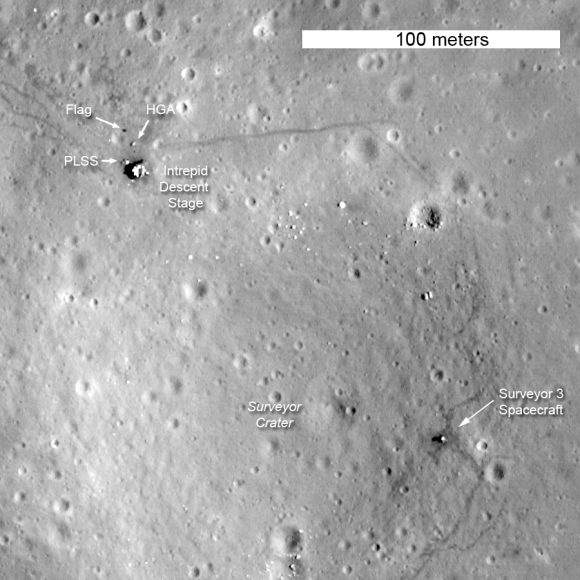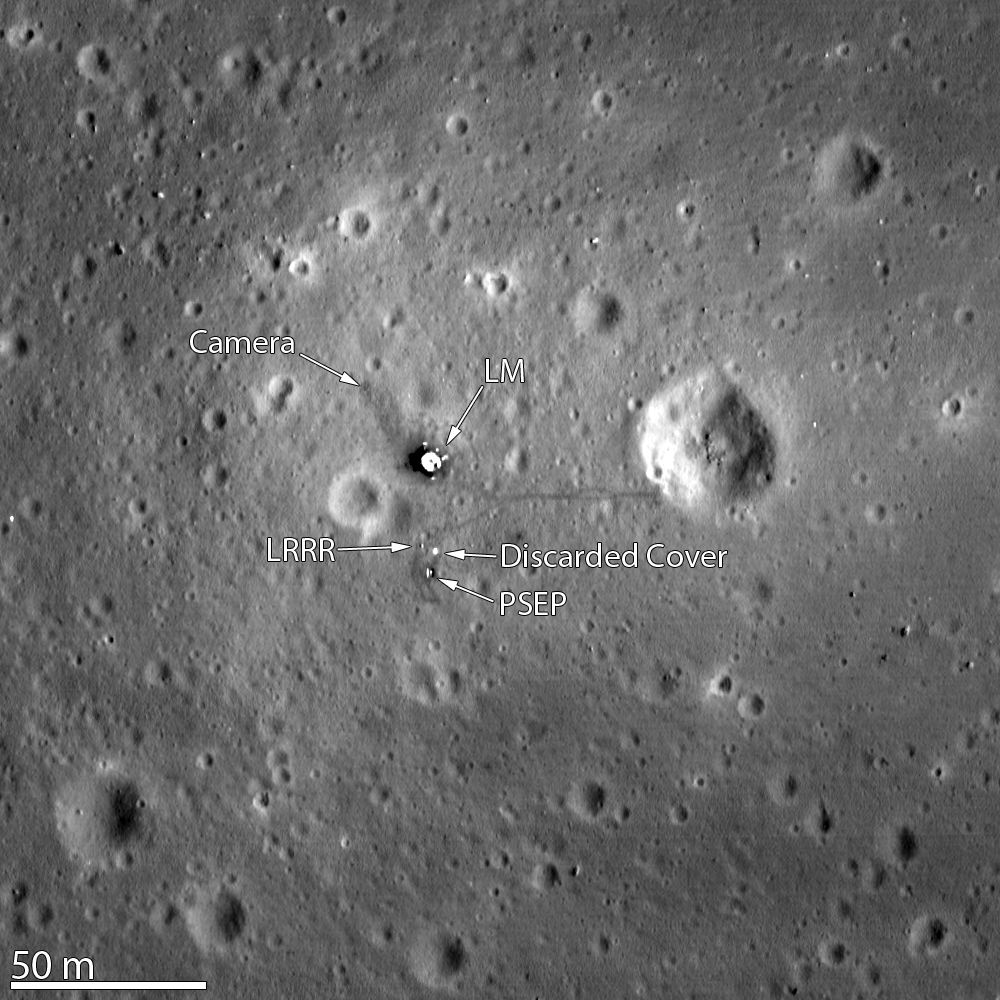[/caption]
Just over 42 years after Neil and Buzz became the first humans to experience the “stark beauty” of the lunar surface, the Lunar Reconnaissance Orbiter captured the remnants of their visit in the image above, acquired Nov. 5, 2011 from an altitude of only 15 miles (24 km). This is the highest-resolution view yet of the Apollo 11 landing site!
The Lunar Module’s descent stage, a seismic experiment monitor, a laser ranging reflector (LRRR, still used today to measure distances between Earth and the Moon) and its cover, and a camera can be discerned in the overhead image… as well as the darker trails of the astronauts’ bootprints, including Armstrong’s jaunt eastward to the rim of Little West crater.
The crater was the furthest the Apollo astronauts ventured; in fact, if you take the total area Neil and Buzz explored it would easily fit within the infield of a baseball diamond!
Neil Armstrong’s visit to the crater’s edge was an unplanned excursion. He used the vantage point to capture a panoramic image of the historic site:

“Isn’t that something! Magnificent sight out here.” Armstrong had stated before he was joined by Aldrin on the lunar surface. “It has a stark beauty all its own. It’s like much of the high desert of the United States. It’s different, but it’s very pretty out here.”
Previously the LROC captured the Apollo 15 landing site, which included the tracks of the lunar rover — as well as the rover itself! And, just yesterday, the LROC site operated by Arizona State University featured the latest similarly high-resolution view of the Apollo 12 site. This location has the honor of being two landing sites in one: Apollo 12 and the Surveyor 3 spacecraft, which had landed on April 20, 1967 – two and a half years earlier!

Even though the US flag planted by Apollo 12 astronauts Pete Conrad and Alan Bean isn’t itself visible, the shadow cast by it is.
Apollo 12 was the only mission to successfully visit the site of a previous spacecraft’s landing, and it also saw the placement of the first Apollo Lunar Surface Experiments Package (ALSEP), which included a seismometer and various instruments to measure the lunar environment.
Read more about this image on the LROC page here, and check out the video tour below of the Apollo 12 site.
Images and video courtesy of NASA/GSFC/Arizona State University


Unbelievable! Mankind’s first steps off the earth, frozen in history…
[sarcasam] That cant be right. Man has never been to the moon. All the conspiracy theorists tell us so. Even the never wrong Michael Moore says so. How could such an upstanding person possibly be wrong? [/sarcasam]
now they will question these photos…
Nice to see the evidence ever increasing against the non-believers!
Amazing to think that people might still be reflecting on these images in thousands of years time, the first interplanetary voyages of the ancients.
Amazing how much has changed on planet Earth in just 43 years.I was 19 at the time of the 1st moon landing. I remember being fixated by the images returning from the Moon. This was the culmination of following every manned space flights since 1961. I so wanted to be an astronaut. Alas, not this lifetime.
If we had been not preoccupied with other things(like Vietnam) we’d be on
Mars now trying to figgure out how to get to Alpha Centauri..
For those who want to dismiss the achievement of the moon landings, I would ask you to spend some time going over the information in http://www.hq.nasa.gov/alsj/. The evidence for this feat is overwhelming. Think of Harrison Schmitt, the LMP of Apollo 17 and only geologist ever to explore the moon, handling the rocks each evening in the lunar module. When he got back, moon dust was so caked under his finger nails that it took a month to grow out. Or the suits worn on the moon’s surface peppered with micro-meteorite impacts. Or the thousands of people who worked in real time with the astronauts during the missions guiding them as they explored on the surface and monitoring the communication between the ships and Earth.
To dismiss the reality of the moon landings one is missing out on the most lasting and consequential events of human evolution. If, as some people think, humans fall into another dark age and eventually become extinct, then the artifacts on the moon will be the only record of human’s existence. Perhaps in another hundreds of millions of years, a new sentient species will evolve on Earth and through its scientific endeavors, find and explain a mysterious and unique geological layer that is all that is left of our civilization. Then when they engineer space ships and go to the moon, they will find perfectly preserved human suits, machines and even waste we left there and put together a clear picture of who we were and what we achieved.
Maybe they will even work out what we did wrong to cause our own extinction and use this knowledge to avoid the same mistake?